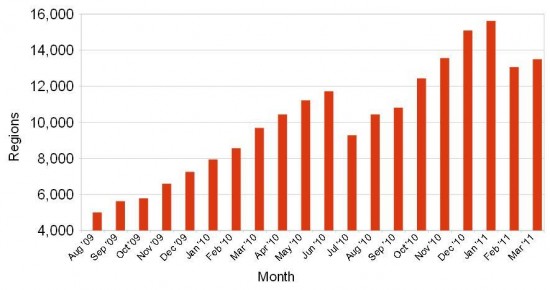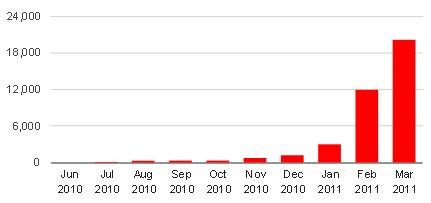The world’s top 40 public OpenSim grids gained 424 regions and 12,746 registered users since the middle of February, a slightly slower than usual growth rate.

However, we’re continuing to see growth in private and mini-grids. For example, 466 new copies of the Diva Distro were downloaded last month.This does not mean that 466 new grids have been created — not everyone who downloads the Diva Distro sets up a grid, while others may download the software once and use it to set up multiple grids.
The Diva Distro is a pre-configured four-region mini grid created by hypergrid inventor and OpenSim core developer Crista Lopes, a professor at UC Irvine. Lopes also distributes a free set of terrain files and an inventory archive — IAR — jam packed with useful freebies for a new grid.
In addition, there are several other distributions of OpenSim, including the official one at OpenSimulator.org, none of which keep track of download numbers.

One interesting new grid this month is Curiosity Grid, operated by the folks behind 3rd Rock Grid, and run on technology from PioneerX Estates. With seven regions and 57 users, it was too small too make it into our top-40 list this month, but is unique in that it is a new commercial grid dedicated specifically to education and is access-restricted.
“All avatar accounts are associated with a specific sponsoring institution,” 3Rd Rock Grid manager Thoria Millgrove told Hypergrid Business. Self-registration through the website is not allowed.
Region prices are not finalized, Millgrove said, “but it will be significantly lower than equivalent land in Second Life.”
The grid already has some freebie stores, an orientation area, and an anchor tenant — South Carolina’s Clemson University.
“Palmetto Island is a project developed at Clemson University to create an interactive, online informal learning environment for middle and high school students,” wrote Clemson professor Larry Hodges in a post about the project. “Palmetto Island is designed to help students learn computing skills such as programming, three-dimensional modeling, avatar design and animation—all in the context of a virtual world that also provides opportunities for mentoring by Clemson computer science majors and professors, and by professionals working in the information technology industry.”
ReactionGrid and JokaydiaGrid are also education-friendly, but anyone can register and create an account. Other schools and universities have been going the fully-private route, using ReactionGrid, other hosting providers, or their own in-house technology staff to create separate grids just for their own students and teachers.
Curiosity Grid is the first attempt to create a grid similar to Second Life’s Teen Grid, a gated community for a variety of different educational institutions.
Those interested in finding out more about Curiosity Grid can contact them by email at support@3rdrockgrid.com.
Other new grids this month include the tropical island-themed Island Oasis grid, education-oriented SecondLearning, and German-language Universe Grid.
OSGrid tops in region growth
After last month’s cleaning out of unused region slots, OSGrid returned to its place at the top of the growth charts, gaining 318 new regions for a new total of 6,076. OSGrid is a non-profit grid that allows anyone to connect regions, even regions running for free on home computers. There are also a number of third-party hosting vendors offering OSGrid regions, including a $9.95 per month deal from New Voice for a full region. (Full list of OpenSim hosting providers here.)
However, a low-cost region isn’t going to be able to offer the best performance. OpenSim users typically pay around $50 a month for a moderate-use region, and around $90 for a heavily trafficked region, though there are plenty of discounts to be had if buying in bulk.
OSGrid is a hypergrid-enabled grid, allowing users to teleport to other OpenSim grids and to standalones and mini-grids like the Diva Distros.
Role playing grid Avination was in second place this month in terms of region growth, gaining 202 regions. It also held on to its place as the second-largest public grid, with a total of 1,126 regions. Avination is a closed commercial grid, with no hypergrid teleports allowed, to protect the rights of content creators. It also offers an in-grid currency and a combat system.
As a result of its protected community, it has attracted a growing number of content producers, event organizers and other businesses — and is able to charge slightly higher rates — $60 per basic region, $75 for one with the combat system enabled. Unlike other OpenSim grids, Avination also charges users to upload images and to create groups.
Avination is operated by OpenSim core developer Melanie Thielker, CEO of OpenSim hosting company 3D Hosting, and came out of nowhere earlier this year, with marketing campaigns in Second Life and on U.S. radio stations on the west coast.
Avination also announced a major first today: this week, the grid will begin implementing Vivox voice, a popular and high-quality in-world voice platform. Other grids have tried to get a license for the technology but have failed, or found it too expensive for their use. With Vivox voice, the grid is likely to become even more attractive to both new virtual world users and Second Life emigrants.
Meanwhile, another commercial grid — InWorldz — remained the third-largest by size, with a total area of 842 regions, even though it only gained 26 regions this month. Like Avination, InWorldz — the big success story of last summer — is a closed commercial grid, restricting hypergrid teleports and content exports. InWorldz will be celebrating its first birthday on March 31.
InWorldz land prices also start at $60 a month for a full region, and it is known for its supportive community.
Other grids which gained a notable number of regions this month include Logicamp, which grew by 66 regions for a new total of 88 regions. Metropolis gained 54 regions for a new total of 285. And AlphaTowne gained 27 regions for a new total of 323.
MyOpenGrid was the biggest loser, shrinking by 171 regions to a new total of just 75 regions. SimValley also lost more than half its land area, shrinking by 41 regions to a new total of 29.
Avination busiest grid
The big shocker this month was Avination’s active user count — 8,119 active users during the past 30 days. By comparison, OSGrid reported just 3,491 active users. InWorldz does not report active user numbers.
Some of the activity could have been a result of newly registered users logging in to check out the grid for the first time. Avination currently has 20,128 registered users — a whopping 8,151 of whom registered over the past month.

OSGrid now has a total of 58,190 registered users — an increase of 1,285 new users since last month — and InWorldz reports 33,332 registered users, an increase of 2,124.
As usual, several grids have gone offline since we last checked. The French-language Oceax grid was down this month, and the AnSky grid was temporarily down while its servers were upgraded.
Rezzable’s historic-themed Heritage Key grid did not report its usage numbers this month.
“To be honest, we aren’t seeing that much traffic on the Heritage Key grid,” Rezzable CEO Jon Himoff told Hypergrid Business. “I think there are a lot of issues here, but the main one is that people want zappier experiences online. We have some new products coming out targetted at education that should attract a more dedicated userbase.”
For example, Rezzable is getting ready to launch QuestHistory, a set of history-themed educational environments which use a back end system that Rezzable developed and accessed through a Web browser.
“We are also seeing new interest from corporates in the 3D simulation space for training and overview presentations,” Himoff added. “But this is less a virtual world and more a set of Web-deployed scenes.”
Meanwhile, Second Life lost 50 regions since mid February, now totaling 31,502 regions. Since March 2010, the grid has lost a net total of 628 regions, a sign that its land might be slightly overpriced.
March Region Counts on the Top 40 Grids
We are now tracking a total of 126 different publicly-accessible grids, 72 of which reported their region counts this month. The raw data for this month’s report is here.
- OSGrid: 6076 regions
- Avination: 1127 regions
- InWorldz: 842 regions
- Virtual Worlds Grid: 837 regions
- New World Grid: 618 regions
- AlphaTowne: 343 regions
- ScienceSim: 338 regions
- NexXtLife: 289 regions
- Meta7: 287 regions
- Metropolis: 285 regions
- FrancoGrid: 280 regions
- 3rd Rock Grid: 180 regions
- SpotOn 3D: 172 regions
- VirtualLife: 140 regions
- ReactionGrid: 139 regions
- Craft World: 132 regions
- Virtyou: 110 regions
- German Grid: 100 regions
- New Zealand Virtual World Grid: 99 regions
- Logicamp: 88 regions
- JokaydiaGrid: 87 regions
- Tertiary Grid: 76 regions
- Avatar Hangout: 75 regions
- MyOpenGrid: 75 regions
- Twisted Sky: 69 regions
- Open Neuland: 67 regions
- Annuna Grid: 63 regions
- Role Play Worlds: 58 regions
- PMGrid: 56 regions
- SIM World: 55 regions
- Pseudospace: 53 regions
- GerGrid: 52 regions
- Your Alternative Life: 38 regions
- NorthGrid: 34 regions
- YourSimSpot: 29 regions
- SimValley: 29 regions
- Wilder Westen: 28 regions
- Grid World: 23 regions
- UFS Grid: 23 regions
- Virtual RP: 21 regions
- International singers gather on Alternate Metaverse Grid for first annual International Day - April 15, 2024
- OpenSim hits new land, user highs - April 15, 2024
- Wolf Territories rolls out speech-to-text to help the hearing impaired - April 15, 2024
